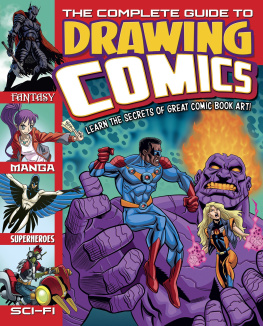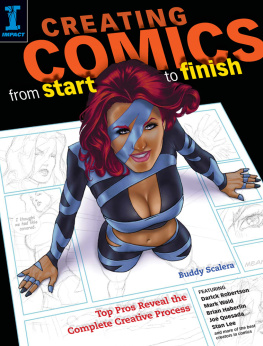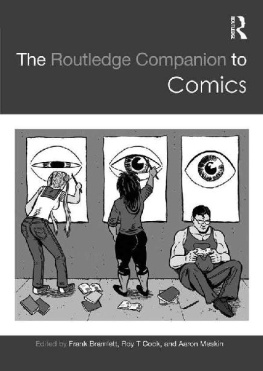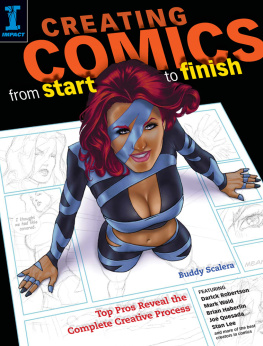The material in this book was first published in print in 2009. It has been reissued in eBook format, with no editorial changes, in 2013.
Copyright 2009 by DC Comics (print edition)
Copyright 2013 by DC Comics (eBook edition)
All related characters and elements are trademarks of and DC Comics.
WB SHIELD: TM & Warner Bros. Entertainment Inc.
(s13)
All artwork, unless otherwise noted, is by Freddie E Williams II

Published in the United States by Watson-Guptill Publications,
an imprint of the Crown Publishing Group,
a division of Random House, Inc., New York.
www.crownpublishing.com
www.watsonguptill.com
Library of Congress Cataloging-in-Publication Data Available
eISBN: 978-0-8230-0832-2
Executive Editor: Candace Raney
DC Comics Supervising Editor: John Morgan
Art Director: Jess Morphew
Editor: James Waller
Designer: Kapo Ng@A-Men Project
Cover Illustrations: Freddie E Williams II
All rights reserved.
v3.1
I was told the other day, much to my amusement, that Im a dead artist. Apparently a page of comic art that I drew twenty years ago was sold to a collector for a surprisingly high sum of money, a sum thats usually reserved for an artist who wont be producing any more artwork because hes dead. (Or, as you Americans like to say, passed.) Well, Im currently still in the land of the living and hope to be so for a little whilebut, no, Im not producing any more artwork, at least not in the real world, and havent done so since 1998 when I wentgasp!completely digital!
Since announcing that I do my work solely on a computer, Ive detected a number of curious reactions in people. When Im asked what I do for a living, I tell people Im an artist and for a while bask in their varying degrees of surprise and admirationup till the moment when I say, I do it all on a computer. At which point I can see the glow of enthusiasm in their eyes fade, because doing art on a computer is somehow cheating. Presumably, they think you press a button and the computer draws it for you.
Also, if youre an artist, its assumed that when youve completed your work process you should have a physical artifact to show for it. Something you can hold in your hand or hang on the wallor, if youre fortunate, sell to an enthusiastic collector for lots of money. Not having artwork to sell is the biggestand to me the onlyreason for resisting the computer.
As long as there have been comics, theyve always been digitalby which I mean at any one point the printing ink was either there on the page or it wasnt. The printing process dictated that you had black and you had white, and colors were made up of tiny dots of the three primaries: cyan, magenta, and yellow, just the way they are today. We, the artists, were required to provide drawings that complied with those digital restrictions. If we wanted something other than black or white in our drawing we had to do it with shading, scallop-shaped parallel lines, or cross-hatching, any number of techniques that gave the printing machines what they wanted. The artwork was just an early stage in a mechanical process. It was merely information given to a machine that enabled it to produce the glorious thing itself, the printed page.
I work entirely in Adobe Photoshop. (Other applications are available.) There are lots of nifty things that you can do in Photoshop that you cant do with pen and ink. You can enlarge the image or flip it. You can paint a lighter color over a darker color, and you never have to clean your brush or buy a new one. You have a special tool that allows you to draw curves. You can lasso bits of your drawing and move them about or change their size and, at a stroke, you can undo any mistake you make. There are many other thingstoo many to list herebut try as I might Ive never managed to find the button that gets the computer to draw the picture for me, so when the page is finished I can honestly say that it was done by my own fair hand and not computer generated.
Computers have removed the language barrier between the artists and the machines that print their work on paper. Theyre clever tools, but theyre not for everyone. I recently asked a professional artist if hed ever considered working digitally, and he replied, Nah. I think Ill go on getting my hands dirty. Well, I dont know about you, but Im very pleased he said that and glad there are many more like him, but for those of us who are not particularly wedded to paper or ink or the endless washing out of brushes and pens, the possibilities of digital artas this book will demonstrateare endless.
CONTENTS
Heres my cover for Seven Soldiers: Mister Miracle #3. (Colors by Dave McCaig).
Are you ready to throw your pencils and paper away? Ready to learn how to start and finish a comic book page completely on the computer? If so, youve come to the right place! In these pages, Ill teach you several methods for using the computer to draw comics. But before we get into the nuts and bolts of how to create comic books digitally, Id like to cover a bit of the history of how and why I developed my method of drawing comics digitallyand why I think it can work for you.

Robin and I met at New York Comic Con 2007.
My conversion to the All-Digital Workflow began in early 1999. At the time, I was working for a finicky editor at an independent comic book company who asked me to scan in my rough page layouts (which I drew on 8 11 paper) and email them to him for approval. This editor was very hands-on and made several corrections on nearly every page of my roughs.
At first, I made corrections by redrawing the roughs on paper, scanning them back in, and emailing them, but I quickly realized how much time I was spending at the scannertime I could have used for drawing. So I started making adjustments to my roughs in Adobe Photoshop. Up until then I had mainly used Photoshop for photo touchups and resizing art for my website, but correcting roughs by flipping, resizing, rotating, and restructuring figures taught me many of the programs tools and how they could be used for comics. As my comfort level increased, so did the amount of time I spent drawing in Photoshop. By the end of that first issue I was drawing all my roughs on the computer.
Soon I pressed further into the digital realm, beginning with creating perspective grids for certain panels. Then I started digitally drawing tight breakdowns for every page, which evolved into very tight structure drawings (which I call wireframes) for my pencils. Eventually, I began completing pages, and finally entire issues, on the computer, from roughs to inks.
Flash forward to July 2005 at the international multimedia extravaganza that is the San Diego Comic Convention. Along with a thousand other hopefuls I turned in my portfolio for the DC Comics Talent Search. The following day, to my nervous delight, my name was on the list of four artists whose work would be reviewed in person. About halfway through that review, I told Richard Bruning, the creative director at DC, that I worked entirely digitally. I was nervous, because most of the established professionals I had revealed this to had responded suspiciously. But Richard replied, Really?! I couldnt tell. Then he looked over my portfolio again and minutely analyzed all the pages he had already reviewed. He seemed impressed, and I was relieved.










